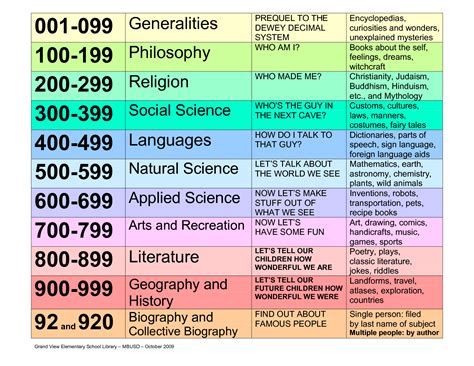The Dewey Decimal System, a cornerstone of library organization, has been a vital tool for librarians and researchers since its inception in 1876. Developed by Melvil Dewey, this system has undergone numerous revisions to accommodate the ever-expanding universe of human knowledge. At its core, the Dewey Decimal System categorizes books and other materials into ten main classes, ranging from 000 to 900, each representing a specific subject area. For individuals seeking to navigate this complex system efficiently, here are five essential tips to enhance your understanding and utilization of the Dewey Decimal System.
Key Points
- Understanding the primary classification categories to quickly locate relevant materials.
- Familiarizing yourself with the decimal expansions within each category for more precise subject matter identification.
- Learning to read call numbers, which include the class number, author number, and sometimes a volume or copy number.
- Recognizing the importance of auxiliary tables for further specification of subjects, especially in areas like geography and language.
- Staying updated with the latest revisions and understanding the potential for variation in classification practices among different libraries.
Understanding the Primary Classification Categories

The Dewey Decimal System is broadly divided into ten main classes: 000 for general works, 100 for philosophy and psychology, 200 for religion, 300 for social sciences, 400 for language, 500 for science, 600 for technology, 700 for arts and recreation, 800 for literature, and 900 for history and geography. Each of these categories is further subdivided into more specific topics, allowing for precise location of materials. For instance, within the 500s, which cover science, 520 represents astronomy, and 550 is dedicated to earth sciences. This hierarchical structure is key to navigating the system effectively.
Decimal Expansions and Specificity
A crucial aspect of the Dewey Decimal System is its ability to expand into more specific topics through decimal points. For example, the 610s, which cover medicine and health, can be further divided into 614 for public health, and more specifically, 614.5 for epidemiology. Understanding these decimal expansions is vital for pinpointing exact subjects of interest within the vast array of available materials.
| Main Class | Description |
|---|---|
| 000 | General works, computer science, and information |
| 100 | Philosophy and psychology |
| 200 | Religion |
| 300 | Social sciences |
| 400 | Language |
| 500 | Science |
| 600 | Technology |
| 700 | Arts and recreation |
| 800 | Literature |
| 900 | History and geography |

Reading Call Numbers and Auxiliary Tables

Call numbers are the unique identifiers assigned to each item in a library’s collection, guiding patrons to the exact shelf location. A call number typically consists of the class number (the Dewey Decimal classification), followed by an author number (which might be based on the author’s name or title), and sometimes a volume or copy number. Additionally, auxiliary tables are used to provide more detailed specifications, particularly for subjects like geography and language, where additional granularity is beneficial.
Auxiliary Tables for Detailed Specifications
Auxiliary tables play a critical role in the Dewey Decimal System by offering a means to further specify subjects that cannot be adequately represented by the standard classification numbers. For instance, Table 2 provides geographical areas, allowing for the precise classification of materials related to specific countries, regions, or cities. This level of specificity is invaluable for researchers requiring detailed information on particular geographical locations.
As libraries continue to evolve, incorporating digital materials and adapting to the needs of a changing user base, the Dewey Decimal System remains a fundamental tool for organizing and accessing knowledge. By grasping the underlying structure of this system and staying abreast of its updates, users can maximize their research efficiency and unlock the full potential of library collections.
What is the primary purpose of the Dewey Decimal System?
+The primary purpose of the Dewey Decimal System is to provide a systematic and organized method for categorizing and shelving books and other materials in libraries, making it easier for users to locate specific topics and subjects.
How are materials classified in the Dewey Decimal System?
+Materials are classified into ten main classes (000-900), each representing a broad subject area. These classes are further subdivided using decimal points to provide more specific categorizations.
What role do auxiliary tables play in the Dewey Decimal System?
+Auxiliary tables are used to provide additional specifications for certain subjects, such as geography and language, allowing for more precise classification and easier location of materials.



